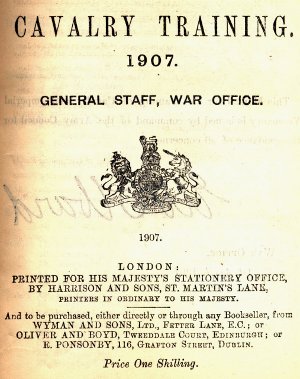Topic: Officers
Cavalry Training; 1907
 S. 142. – The Command and Leading of Cavalry
S. 142. – The Command and Leading of Cavalry
With cavalry, the personality of the commander is the most important factor in success.
The resolute offensive, which is the essence of cavalry action, and the rapidity of movement, which is the characteristic of the arm, allow only the shortest amount of time for consideration. Rapid decisions may therefore have to be made under the most unfavourable conditions. In many cases it will be impossible for the commander of a mass of cavalry to take in correctly the strength and dispositions of the enemy, or to gauge with even approximate accuracy the strength of his adversary from the preliminary resistance he encounters.
Orders must, therefore, be based on a general consideration of the circumstances. Once his squadrons have been launched, the commander can only rely on his intact reserve for influencing the combat.
Only the most strenuous training of the force, combined with high executive talent in the leaders down to the most junior, can compensate for all these difficulties.
A high standard of training, not only in collective action, but also in detached duties, is essential to efficiency in war. All ranks must be trained to manoeuvre swiftly and with precision, to charge in close or open order, and to act dismounted. Whether acting strategically, or in tactical co-operation with other arms, the functions of cavalry comprise both fighting and reconnaissance. Every cavalry soldier must therefore be trained to ride well and be a good horsemaster, to use his intelligence in carrying out reconnoitring duties, to be efficient with the sword or lance, and to supplement these with the rifle when the situation is favourable to its use.
In addition to being efficient in the above subjects, cavalry officers must possess resolution and prompt decision, and have a knowledge of the principles which govern the movements of other arms in the field. The seniors, in order that they might better direct their men; the juniors in order that they might better interpret the movements of the enemy.

